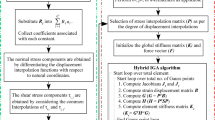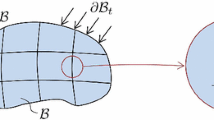Abstract
We present an approach for repartitioning existing lower-order finite element mesh based on quadrilateral or triangular elements for the linear and nonlinear volumetric locking-free analysis. This approach contains two levels of mesh repartitioning. The first-level mesh re-partitioning is an h-adaptive mesh refinement for the generation of a refined mesh needed in the second-level mesh coarsening. The second-level mesh coarsening involves a gradient smoothing scheme performed on each pair of adjacent elements selected based on the first-level refined mesh. With the repartitioned mesh and smoothed gradient, the equivalence between the mixed finite element formulation and the displacement-based finite element formulation is established. The extension to nonlinear finite element formulation is also considered. Several linear and non-linear numerical benchmarks are solved and numerical inf-sup tests are conducted to demonstrate the accuracy and stability of the proposed formulation in the nearly incompressible applications.
Similar content being viewed by others
References
Andrade Pires FM, de Souza Neto EA, de la Cuesta Padilla JL (2004) An assessment of the average nodal volume formulation for the analysis of nearly incompressible solids under finite strains. Int J Numer Methods Eng 20: 569–583
Areias P, Matouš K (2008) Stabilized four-node tetrahedron with nonlocal pressure for modeling hyperelastic materials. J Numer Methods Eng 76: 1185–1201
Arnold DN, Brezzi F, Franca LP (1984) A stable finite element for the Stokes equations. Calcolo 21: 337–344
Arnold DN, Brezzi F, Cockburn B, Marini LD (2001) Unified analysis of discontinuous Galerkin methods for elliptic problems. SIAM J Numer Anal 39: 1749–1770
Auricchio F, Beiraode Veiga L, Buffam A, Lovadina C, Reali A, Sangalli G (2007) A fully locking-free isogeometric approach for plane linear elasticity problems: a stream function formulation. Comput Methods Appl Mech Eng 197: 160–172
Bathe KJ (1996) Finite element procedures. Prentice-Hall, New Jersey
Babuška I (1973) The finite element method with Lagrangian multipliers. Numer Math 20: 179–192
Belytschko T, Lu YY, Gu L (1994) Element-free Galerkin methods. Int J Numer Methods Eng 37: 229–256
Belytschko T, Liu WK, Moran B (2001) Nonlinear finite elements for continua and structures, 3rd edn. Wiley, New York
Bonet J, Burton AJ (1998) A simple average nodal pressure tetrahedral element for incompressible and nearly incompressible dynamic explicit applications. Commun Numer Methods Eng 14: 437–449
Brezzi F, Fortin M (1991) Mixed and hybrid finite element methods, Srpringer Series in Computational Mathematics Vol. 15. Springer, New York
Chen JS, Wu CT, Pan C (1996) A pressure projection method for nearly incompressible rubber hyperelasticity, Part II: applications. J Appl Mech 63: 869–876
Chen JS, Yoon S, Wang HP, Liu WK (2000) An improved reproducing kernel particle method for nearly incompressible finite elasticity. Comput Methods Appl Mech Eng 181: 117–145
Chen JS, Wu CT, Yoon S, You Y (2001) A stabilized conforming nodal integration for Galerkin mesh-free methods. Int J Numer Methods Eng 50: 435–466
Crouzeiz M, Raviart PA (1973) Conforming and nonconforming finite element methods for solving the stationary Stokes equations. RAIRO Sér Rouge 7: 33–75
De S, Bathe KJ (2001) Displacement/pressure mixed interpolation in the method of finite spheres. Int J Numer Methods Eng 51: 275–292
Dolbow J, Belytschko T (1999) Volumetric locking in the element free Galerkin method. Int J Numer Methods Eng 46: 925–942
Elguedj T, Bazilevs Y, Calo VM, Hughes TJR (2008) \({\overline{{B}} }\) and \({\overline{{F}} }\) projection methods for nearly incompressible linear and non-linear elasticity and plasticity using higher-order NURBS elements. Comput Methods Appl Mech Eng 197: 2732–2762
Hansbo P, Larson M (2002) Discontinuous Galerkin methods for incompressible and nearly incompressible elasticity by Nitsche’s method. Comput Methods Appl Mech Eng 191: 1895–1908
Hauret P, Kuhl E, Ortiz M (2007) Diamond elements: a finite element/discrete-mechanics approximation scheme with guaranteed optimal convergence in incompressible elasticity. Int J Numer Methods Eng 72: 253–294
Hughes TJR (2000) The finite element method. Prentice-Hall, Englewood Cliffs, NJ
Hughes TJR, Franca P, Balestra M (1986) A new finite element formulation for fluid dynamics, V. Circumventing the Babuška-Brezzi condition: a stable Petrov-Galerkin formulation of the Stokes problem accommodating equal order interpolation. Comput Methods Appl Mech Engrg 59: 85–99
Hughes TJR, Cottrell JA, Bazilevs Y (2005) Isogeometric analysis: CAD, finite elements, NURBS, exact geometry and mesh refinement. Comput Methods Appl Mech Eng 194: 4135–4195
Krysl P, Zhu B (2008) Locking-free continuum displacement finite elements with nodal integration. Int J Numer Methods Eng 76: 1020–1043
Lamichhane BP (2009) Inf-sup stable finite element pairs based on dual meshes and bases for nearly incompressible elasticity. IMA J Numer Anal 29: 404–420
Liu WK, Ong JSJ, Uras RA (1986) Finite element stabilization matrices—a unification approach. Comput Methods Appl Mech Eng 53: 13–46
Liu WK, Jun S, Li S, Adee J, Belytschko T (1995) Reproducing kernel particle methods for structural dynamics. Int J Numer Methods Eng 38: 1655–1679
Lovadina C, Auricchio F (2003) On the enhanced strain technique for elasticity problems. Comput Struct 81: 777–787
Malkus DS, Hughes TJR (1978) Mixed finite element methods-reduced and selective integration techniques: a unification of concepts. Comput Methods Appl Mech Eng 15: 63–81
Oden JT, Kikuchi N, Song YJ (1982) Penalty-finite element methods for the analysis of Stokesian flows. Comput Methods Appl Mech Eng 31: 297–329
Ortiz A, Puso MA, Sukumar N (2010) Maximum-Entropy meshfree method for compressible and near-incompressible elasticity. Comput Methods Appl Mech Eng 199: 1859–1871
Park CK, Wu CT, Kan CD (2011) On the analysis of dispersion property and stable time step in meshfree method using the generalized meshfree approximation. Finite Elem Anal Des 47: 683–697
Puso MA, Solberg J (2006) A stabilized nodally integrated tetrahedral. Int J Numer Methods Eng 67: 841–867
Simo JC, Hughes T (1986) On the variational foundation of assumed strain methods. ASME J Appl Mech 53: 51–54
Simo JC, Rifai MS (1990) A class of mixed assumed strain methods and the method of incompatible modes. Int J Numer Methods Eng 29: 1595–1638
Stenberg R (1990) Error analysis of some finite element methods for the Stokes problem. Math Comput 54: 495–508
Stevenson AC (1943) Some boundary problems of two-dimensional elasticity. Philos Mag 34: 766–793
Timoshenko SP, Goodier JN (1970) Theory of elasticity, 3rd edn. McGraw-Hill, New York
Vidal Y, Villon P, Huerta A (2003) Locking in the incompressible limit: pseudo-divergence-free element free Galerkin. Commun Numer Methods Eng 19: 725–735
Washizu K (1982) Variational methods in elasticity and plasticity, 3rd edn. Pergamon Press, New York
Wriggers P, Mueller-Hoeppe DS, Loehnert S (2009) Brick elements for finite deformations based on macro-concepts and on inhomogeneous enhancement. Comput Methods Appl Sci 14: 33–48
Wu CT, Hu W (2011) Meshfree enriched simplex elements with strain smoothing for the finite element analysis of compressible and nearly incompressible solids. Comput Methods Appl Mech Eng 200: 2991–3010
Wu CT, Koishi M (2009) A meshfree procedure for the microscopic analysis of particle-reinforced rubber compounds. Interact Multiscale Mech 2: 147–169
Wu CT, Park CK, Chen JS (2011) A generalized meshfree approximation for the meshfree analysis of solids. Int J Numer Methods Eng 85: 693–722
Zienkiewicz OC, Taylor RL (1987) The finite element method, 3rd edn. McGraw-Hill, London
Author information
Authors and Affiliations
Corresponding author
Rights and permissions
About this article
Cite this article
Wu, C.T., Hu, W. A two-level mesh repartitioning scheme for the displacement-based lower-order finite element methods in volumetric locking-free analyses. Comput Mech 50, 1–18 (2012). https://doi.org/10.1007/s00466-011-0665-7
Received:
Accepted:
Published:
Issue Date:
DOI: https://doi.org/10.1007/s00466-011-0665-7




